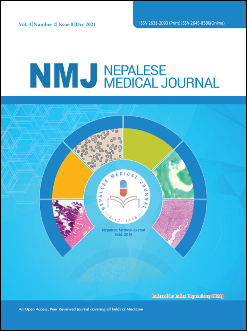Histomorphological Pattern of Malignant Skin Tumors – A Cross-sectional Study in a Teaching Hospital
DOI:
https://doi.org/10.3126/nmj.v4i2.41335Keywords:
Basal Cell Carcinoma, Malignant melanoma, Non-melanoma skin cancer, Squamous cell carcinomaAbstract
Introduction: The incidence of skin cancer is increasing exponentially around the world. This study aims to analyze different malignant skin tumors concerning age pattern, gender, and site-wise distribution.
Materials and Methods: This is a descriptive cross-sectional hospital-based study carried out in the Department of Pathology, a tertiary care center for over ten years from April 2011 to March 2021. All malignant skin tumors arising from the epidermis along with melanocytic and adnexal tumors were included in the study.
Results: A total of 208 cases of skin malignancies among which 117 (56.3%) cases were males and 91 (43.8%) females with a male to female ratio of 1.3:1. Overall, the majority were seen in the sixth decade 49 (23.6%) with head and neck region 113 (54.3%) being the commonest site of involvement. Basal cell carcinoma 79 (38%) was the most frequent non-melanoma skin cancer followed by squamous cell carcinoma 75 (36.1%). A maximum number of basal cell carcinoma were observed in the sixth decade 19 (24.1%) whereas squamous cell carcinoma in the seventh decade 21 (28%) cases. Other skin cancers were malignant melanoma 31 (14.9%), verrucous carcinoma 13 (6.3%), trichilemmal carcinoma five (2.4%), sebaceous carcinoma two (1%), and one case each of eccrine carcinoma, malignant nodular hidradenoma, and malignant proliferating trichilemmal tumor.
Conclusions: Skin malignancies were seen in the sixth decade with male preponderance. Overall, the head and neck region was the commonest site of involvement. Basal cell carcinoma was the most frequent non-melanoma skin cancer followed by squamous cell carcinoma.
Downloads
Downloads
Published
How to Cite
Issue
Section
License
Copyright (c) 2021 Sushma Thapa, Arnab Ghosh, Dilasma Ghartimagar, Sudeep Regmi, Adarsh Kumar Jhunjhunwala

This work is licensed under a Creative Commons Attribution 4.0 International License.
This license enables reusers to distribute, remix, adapt, and build upon the material in any medium or format, so long as attribution is given to the creator. The license allows for commercial use.
Copyright on any article published by Nepalese Medical Journal is retained by the author(s).
Authors grant Nepalese Medical Journal a license to publish the article and identify itself as the original publisher.
Authors also grant any third party the right to use the article freely as long as its integrity is maintained and its original authors, citation details and publisher are identified.




